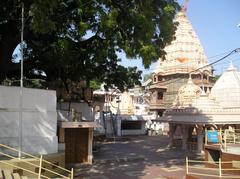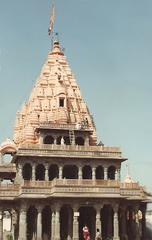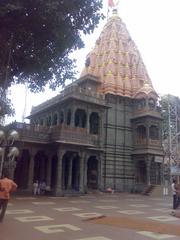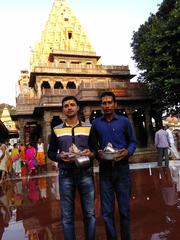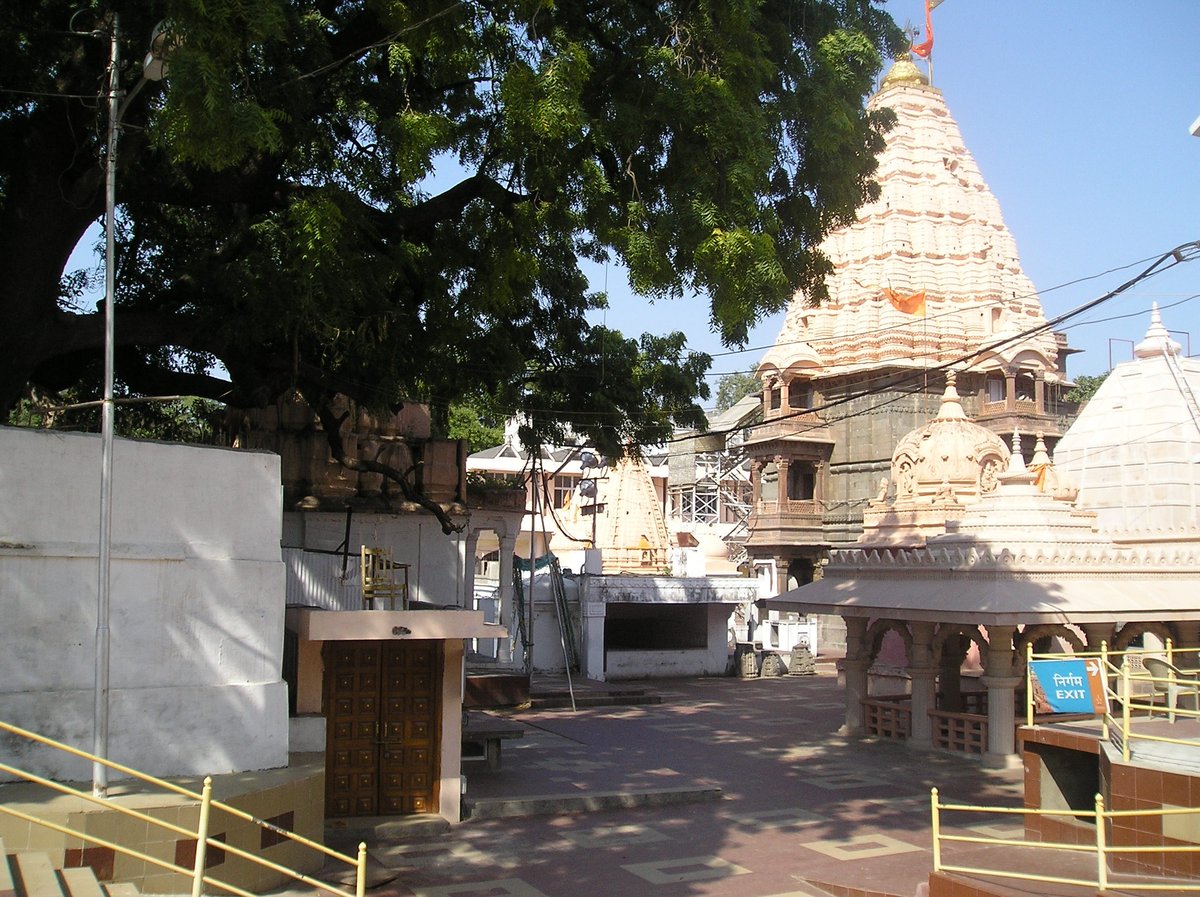
Mahakaleshwar Jyotirlinga Visiting Hours, Tickets, and Guide to Ujjain Historical Site
Introduction
Nestled in the ancient city of Ujjain, Madhya Pradesh, Mahakaleshwar Jyotirlinga is among the twelve most sacred shrines dedicated to Lord Shiva. The temple, renowned for its unique south-facing Swayambhu (self-manifested) lingam and the iconic Bhasma Aarti ritual at dawn, draws millions of pilgrims and tourists every year. Ujjain itself, historically referred to as Avantika, is a city steeped in mythology and spirituality, and is one of India’s revered seven Moksha-puris—destinations believed to grant liberation to devotees (DharmikVibes; HindUtsav; pilgrimagetour.in).
The Mahakaleshwar temple is not only a spiritual hub but also a testament to India’s rich architectural and cultural legacy. Its five-storey structure, intricate carvings, and rare underground sanctum blend the Bhumija and Nagara architectural styles, reflecting centuries of devotion and endurance. This comprehensive guide covers Mahakaleshwar Jyotirlinga’s visiting hours, ticketing procedures, daily rituals, festivals, accommodation, nearby attractions, and practical tips for a fulfilling experience.
Temple Overview and Significance
- Jyotirlinga Status: One of the twelve most sacred Shiva shrines, revered as a manifestation of Lord Shiva’s infinite light.
- Swayambhu Lingam: The lingam is believed to be self-manifested, enhancing its spiritual significance.
- South-Facing Orientation: Unique among Jyotirlingas, symbolizing Shiva as Mahakal—the Lord of Time and Death.
- Mythological Roots: Linked to epics like the Mahabharata and Ramayana, and associated with liberation (moksha).
- [Historical Resilience: Survived invasions and reconstructions, notably rebuilt in the 18th century by Maratha rulers (pilgrimagetour.in; shivamahadeva.net).](#historical-resilience:-survived-invasions-and-reconstructions,-notably-rebuilt-in-the-18th-century-by-maratha-rulers-(pilgrimagetour.in;-shivamahadeva.net).)
Visiting Hours and Ticket Information
Temple Timings
- General Darshan: 4:00 AM – 12:00 PM and 4:00 PM – 9:00 PM daily.
- Bhasma Aarti: Conducted at 4:30 AM each morning; advance booking is essential for participation (shrimahakaleshwar.com; bhasmarti.com).
Ticketing and Booking
- General Entry: Free for all devotees.
- Bhasma Aarti: Tickets required, available online through shrimahakaleshwar.com and bhasmarti.com. Advance booking is highly recommended, especially during festivals.
- Special Darshan & VIP Entry: Additional charges may apply; refer to the official website for details.
- Dress Code: Traditional attire required for entry to the sanctum during Bhasma Aarti (men: dhoti; women: saree or salwar-kameez). Western attire is discouraged.
Accessibility
- Ramps and wheelchairs are available for differently-abled visitors.
- Assistance for elderly and special needs devotees can be requested at the temple office.
Daily Rituals and Worship Practices
Bhasma Aarti
- Timing: 4:30 AM daily.
- Significance: Ritual adornment of the Shiva Lingam with sacred ash, symbolizing the cycle of life and death. Only a limited number of devotees can participate; traditional attire is mandatory. Photography and videography are strictly prohibited (traveltriangle.com).
- Booking: Online or at the temple office.
Other Daily Aartis
- Dadyodak Aarti: Post-Bhasma Aarti, involves curd and water offerings.
- Bhog Aarti: Afternoon food offering.
- Sandhya Aarti: Evening lamp worship.
- Shayan Aarti: Final ritual before temple closure (pilgrimagetour.in).
Nitya Yatra
A traditional pilgrimage circuit starting with a holy dip in the Shipra River, followed by visits to adjacent shrines such as Nagachandreshwara, Koteswara, Harasiddhi, and Agastheswara (travelsnwrite.com).
Major Festivals and Celebrations
- Mahashivratri: Temple illuminated, special rituals and night-long vigils; one of the largest gatherings (tripoto.com).
- Shravan Maas (July–August): Mondays are especially auspicious; elaborate pujas and processions.
- Sawari Events: Processions every Monday during certain Hindu months; the final Sawari is a major citywide event.
- Simhastha Kumbh Mela: Every 12 years, Ujjain hosts millions of pilgrims for holy dips and temple visits (instaastro.com).
- Naag Panchami: The upper-floor Nagachandreshwar Lingam is open for darshan only on this day (triphippies.com).
Architectural Highlights
- Five-Storey Structure: Includes an underground sanctum, rare among Indian temples.
- Bhumija and Nagara Styles: Tall shikharas, ornate carvings, and pillared halls (templeyatri.in).
- Mahakal Corridor: New 900-meter-long promenade with murals, sculptures, and sandstone pillars leading to the temple (hindfiri.com).
- Intricate Carvings: Depicting deities and mythological stories.
- Central Courtyard: Gathering space for rituals and processions.
Travel Planning and How to Reach
By Air
- Nearest Airport: Devi Ahilyabai Holkar Airport, Indore (approx. 55 km).
- Transfer: Taxis and buses are available; journey takes about 1–1.5 hours (Delhi Tempo Travellers).
By Train
- Ujjain Junction (UJN): Connected to major Indian cities.
- Malwa Express (12919/12920) and NDLS INDB Express (12416) connect Delhi and Ujjain.
By Road
- From Delhi: Around 770 km (approx. 14 hours).
- Local Transport: Auto-rickshaws, taxis, and buses are easily available.
Group Travel
- Tempo Travellers: 9–25 seater vans available for group travel (Delhi Tempo Travellers).
Accommodation Near Mahakaleshwar Jyotirlinga
Where to Stay
- Nearby Hotels: Options range from budget to luxury, many within walking distance of the temple (Booking.com).
- Popular Choices: Hotel Abika Elite, Solitaire Hotel and Resorts, Hotel Bholenath Palace, A-P Ujjain Hotel & Suites.
- Budget Options: Hotel M-Inn, Shree Ram Kuti, Spiritual Backpackers Hostel.
- Luxury: Hotel Tirupati Ujjain, Govinda Palace Luxury Hotel (New Hotels Guide).
- Amenities: Air conditioning, Wi-Fi, breakfast, parking, accessible rooms.
- Price Range: Budget stays from ₹500, mid-range ₹1,500–₹2,500, luxury above ₹2,981 per night (Holidify).
Local Attractions and Itinerary
Must-Visit Spiritual Sites
- Harsiddhi Temple: Revered Shakti Peetha.
- Kal Bhairav Temple: Noted for unique liquor offerings.
- Ram Ghat: Sacred riverfront, especially vibrant at evening aarti.
- Sandipani Ashram: Linked to Lord Krishna and ancient education.
Historical & Cultural Spots
- Jantar Mantar (Vedh Shala): Astronomical observatory.
- Bhartrihari Caves: Peaceful caves with spiritual significance.
- Kaliyadeh Palace: Historical riverside palace.
- Vikram Kirti Mandir Museum: Artifacts and Ujjain history (Holidify).
Parks, Leisure, and Food
- Atal Park, Vishnu Sagar Taalab: Green spaces.
- Meghdoot Resort Water Park, WWF Water Park: Family-friendly recreation.
- Local Cuisine: Samosa, kachori, poha, jalebi, kulfi (Tusk Travel).
Sample 3-Day Itinerary
Day 1:
- Arrive, check in near Mahakaleshwar Temple, attend Bhasma Aarti, visit Harsiddhi Temple.
Day 2:
- Kal Bhairav Temple, Sandipani Ashram, Ram Ghat, street food exploration.
Day 3:
- Jantar Mantar, Bhartrihari Caves, Kaliyadeh Palace, or optional day trip to Omkareshwar.
Local Tips
- Dress modestly; traditional attire is preferred, especially during rituals.
- Footwear must be removed before entering temple premises.
- Safety: Ujjain is generally safe, but standard precautions are advised.
- Language: Hindi widely spoken; English understood in tourist areas.
- Connectivity: Mobile networks are strong; Wi-Fi available at most hotels.
Frequently Asked Questions (FAQs)
Q1: What are the visiting hours of Mahakaleshwar Jyotirlinga?
A1: The temple is open from 4:00 AM to 12:00 PM and 4:00 PM to 9:00 PM daily. Bhasma Aarti is held at 4:30 AM.
Q2: How can I book tickets for Bhasma Aarti?
A2: Book online at shrimahakaleshwar.com or bhasmarti.com.
Q3: Is the temple accessible for differently-abled visitors?
A3: Yes, ramps and wheelchairs are available.
Q4: What is the best time to visit Ujjain?
A4: October to March offers pleasant weather. Festivals such as Maha Shivaratri and Shravan Maas are vibrant but crowded.
Q5: Are there dress codes?
A5: Yes, modest and traditional attire is recommended; dhoti for men and saree/salwar-kameez for women during Bhasma Aarti.
Conclusion
Mahakaleshwar Jyotirlinga stands as a beacon of spirituality, mythology, and Indian heritage. Its unique rituals, architectural beauty, and the vibrant culture of Ujjain make it a must-visit for pilgrims and history enthusiasts alike. For a seamless experience, plan ahead—book your Bhasma Aarti ticket in advance, select suitable accommodation, and schedule visits to nearby historical sites. Embrace the traditions, respect temple customs, and immerse yourself in one of India’s most sacred destinations.
For the latest updates, real-time assistance, and guided tour options, download the Audiala app. Stay connected through our social media channels for more travel inspiration and tips.
Sources and Further Reading
- DharmikVibes - Mahakaleshwar Temple Ujjain: Visiting Hours, Tickets & Historical Guide
- PilgrimageTour.in - Discovering Mahakaleshwar Jyotirlinga: Architectural Marvel, Cultural Heritage, and Visitor Guide
- TravelTriangle & Tripoto - Mahakaleshwar Temple Ujjain: Visiting Hours, Tickets, Rituals & Travel Guide
- Delhi Tempo Travellers - Mahakaleshwar Jyotirlinga Visiting Hours, Tickets, and Travel Guide to Ujjain Historical Sites
- HindUtsav: Mahakaleshwar Temple Overview
- Shivamahadeva.net: Mahakaleshwar Temple History and Architecture
- TempleYatri.in: Mahakaleshwar Temple Architecture and Legends
- TuskTravel.com: Things to Do in Ujjain
- TravelSnWrite.com: Guide to Visit Mahakaleshwar Temple
- Hindfiri.com: Ujjain Mahakaleshwar Temple Guide
- TripHippies.com: Shri Mahakaleshwar Jyotirlinga Temple Ujjain
- Apnayatra.com: Mahakaleshwar Jyotirlinga
- Instaastro.com: Mahakaleshwar Jyotirlinga Information
- Holidify.com: Ujjain Sightseeing and Accommodation
- Booking.com: Hotels Near Mahakaleshwar Jyotirlinga
- New Hotels Guide: Ujjain Hotels
